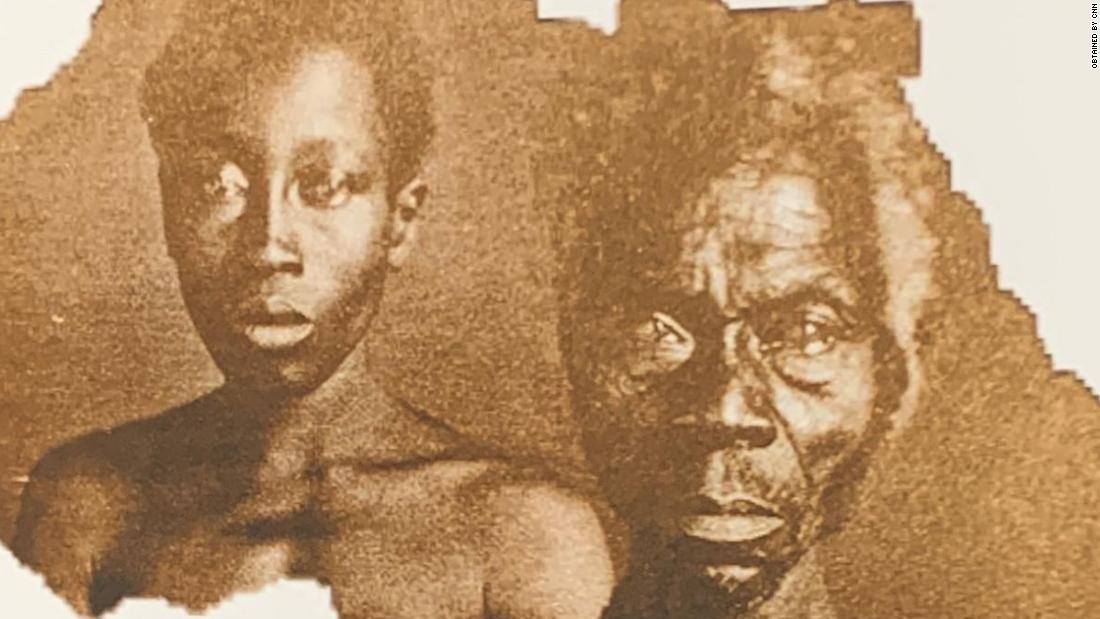Harvard Sued Over Ownership of Slave Photos
A racist scholar took some fascinating photos of an enslaved man in 1860. Now, his descendants want the rights to them.

USA Today (“Harvard University sued over allegedly profiting from what are believed to be the earliest photos of American slaves“):
In 1850, a Swiss-born Harvard University professor commissioned what are believed to be the earliest photos of American slaves.
The images, known as daguerreotypes and taken in a South Carolina studio, are crude and dehumanizing – and they were used to promote racist beliefs.
Among the photographed: an African man named Renty and his daughter, Delia. They were stripped naked and photographed from several angles. Former professor Louis Agassiz, a biologist, had the photos taken to support an erroneous theory called polygenism that he and others used to argue that African-Americans were inferior to white people.
Now, a woman who says she is a direct descendant of that father and child – Tamara Lanier, the great-great-great granddaughter of Renty – is suing Harvard over the photos.
She has accused Harvard of the wrongful seizure, possession and monetization of the images, ignoring her requests to “stop licensing the pictures for the university’s profit” and misrepresenting the ancestor she calls “Papa Renty.”
The university still owns the photos. Lanier, who lives in Connecticut and filed the suit against Harvard in Middlesex County Superior Court on Wednesday, is seeking an unspecified amount of damages from Harvard. She’s also demanding that the university give her family the photos.
In an interview with USA TODAY, Lanier said she has presented Harvard with information about her direct lineage to Renty since around 2011, but the school has repeatedly turned down her requests to review the research.
“This will force them to look at my information,” Lanier said. “It will also force them to publicly have the discussion about who Renty was and restoring him his dignity.”
The suit, which lays out eight different legal claims, cites federal law over property rights, the Massachusetts law for the recovery of personal property and a separate state law about the unauthorized use of a name or picture for advertising purposes.
It also singles out the 13th Amendment to the Constitution, which abolished slavery, arguing that Harvard’s possession of the photos “reflects and is a continuation of core components or incidents of slavery.”
[…]
The photos taken in 1850 of Renty, Delia and 11 other slaves disappeared for more than a century but were rediscovered in 1976 in the attic of Harvard University’s Peabody Museum of Archaeology and Ethnology.
One of the photos of Renty, showing him waist-up as he looks defiantly into the camera, has four decades later turned into an iconic image of slavery in the U.S.
The lawsuit argues that Harvard has used the Renty images to “enrich itself.” The image is on the the cover of a 2017 book, “From Site to Sight: Anthropology, Photography and the Power of Imagery,” published by the Peabody Museum and sold online by Harvard for $40.
The photo also was displayed on the program for a 2017 conference that Harvard’s Radcliffe Institute for Advance Study hosted on the school’s relationship with slavery.
According to Lanier’s attorneys, Harvard requires that people sign a contract in order to view the photos and pay a licensing fee to the university to reproduce the images.
“These images were taken under duress, and Harvard has no right to keep them, let alone profit from them,” Koskoff said. “They are the rightful property of the descendants of Papa Renty.”
Acknowledging up front that I’m not an attorney and have only passing familiarity with the applicable body of law, Lanier’s legal claims strike me as rather silly. There’s no reason to think that Agassiz violated any laws in taking the photographs or had any reason to think he didn’t have to right to do so. There’s every reason to believe that Harvard has the rights to said photographs.
Indeed, as a NYT report (“Who Should Own Photos of Slaves? The Descendants, not Harvard, a Lawsuit Says“) notes, she may have difficulty even proving she’s Renty’s descendant.
The lawsuit could hinge on evidence of that chain of ancestry. Ms. Lanier’s amateur sleuthing led to death records, census records and a handwritten inventory from 1834 of the slaves on the plantation of Col. Thomas Taylor in Columbia and their dollar values.
The slave inventory lists a Big Renty and a Renty, and listed under the latter is Delia. Ms. Lanier believes that Big Renty is her “Papa Renty” and the father of Renty and Delia, and has traced them to her mother, who was born to sharecroppers in Montgomery, Ala.
Her genealogical research has its skeptics. Gregg Hecimovich, who is contributing to a book about the slave daguerreotypes, to be published by the Peabody next year, said it was important to note that the slave inventory has the heading “To Wit, in Families.” Big Renty and Renty are at the top of separate groupings, he said, implying that they are the heads of separate families.
“I’d be very excited to work with Tamara,” said Dr. Hecimovich, who is chairman of the English department at Furman University. “But the bigger issue is it would be very hard to make a slam-dunk case that she believes she has.”
Molly Rogers, the author of a previous book about the images called “Delia’s Tears,” said that tracing families under slavery was extremely complex. “It’s not necessarily by blood,” she said. “It could be people who take responsibility for each other. Terms, names, family relationships are very much complicated by the fact of slavery.”
One intellectual property lawyer, Rick Kurnit, said he thought Ms. Lanier would have a hard time claiming ownership of the daguerreotypes. He said the famous photograph “V-J Day in Times Square,” for instance, belonged to the photographer and not to the sailor or the nurse who are kissing. But that image, of course, was taken in a public space.
Yxta Maya Murray, a professor at Loyola Law School, Los Angeles, said that images taken by force were tantamount to robbery. “If she’s a descendant, then I would stand for her,” Professor Murray said of Ms. Lanier.
Still, presuming she’s indeed Renty’s natural heir, I’m at least mildly sypathetic to Lanier’s moral claims. While not perfectly parallel, they strike me as similar to those of civilizations in the developing world whose antiquities were discovered by Western colonizers or explorers and expatriated for various Western museums. While presumably perfectly legal at the time, we’ve subsequently re-examined our policies on such matters and oftentimes recognize aboriginal claims.
In both situations, though, I’m somewhat torn on a “greater good” principle. Humankind may well be better off with prescious historical artifacts under the control of professional curators and scholars. I haven’t the slightest idea what Lanier and her progeny would do with the images of “Papa Renty” that exist because a Harvard scholar took them and the institution preserved them for generations. But it seems to me that Harvard has done right by them in the modern era, notwithstanding the shameful purpose for which they were taken.






Can you imagine Harvard scholars taking a sledgehammer to some ancient artifact and smashing it into a million pieces? No.
If this lawsuit is successful, though, these images will be gone.
I feel a bit of sympathy, but it’s a sympathy stretched to its limits. These photos are out of copyright and so only worth what the market will pay for the physical artifacts. Perhaps they might be put to better use by Mrs Lanier. I’m trying to keep an open mind.
My only idea would be for Harvard to look at the evidence and, if the claims seem even remotely reasonable, then to make a gift of the photos. At some point, it becomes perverse to fight over such things when you are seated on a pile of riches.
Harvard could buy itself a lot of goodwill by agreeing with Ms. Lanier without the expense and time-suck of a lawsuit.
But they’ll probably miss the chance.
Taking and using those photographs without the permission of the subject would be illegal in 47 different ways today. The subject would be entitled to compensation and damages, and probably confiscation of any profits realized by the photographer from use of the images.
It’s one thing to say that it wasn’t illegal at the time; I get that. It’s another thing, though, for Harvard to continue to exploit the photographs on an ongoing basis, hiding behind the loophole that it wasn’t illegal at the time. It seems perfectly reasonable to me that the heirs of the victim are due some compensation for that part, and that they should be able to assert some control over the use of the images.
If nothing else, the optics on this are atrocious. I would expect Harvard to know better.
Wouldn’t the correct answer here that a photo taken in 1850 is now in the public domain and doesn’t “belong” to either party (although Havard may still be liable for previous misuse of the photos)?
@Stormy Dragon:
If that’s the case, then they were in the public domain when Harvard rediscovered them in 1976.
@James Pearce:
You might want to reconsider the optics of this statement.
The physical deguerrotype almost certainly belongs to the photographer, or his descendants.
The rights to publish the image on the deguerrotype are another matter. Either all copyright expired years ago, or a new copyright started when the image was digitized and published (does publication date matter? Is digitizing transformative? Did they do more than scan it?).
There may be a good case that Harvard does not have a copyright on that image, but I don’t see how Ms. Lanier does. If nothing else, there are likely other descendents, and Harvard can find one that supports the image being used.
On a moral level: history belongs to all of us. Harvard should give up any copyright claim they have to the image. It’s probably not ever going to be a big seller anyway.
(If the next big thing is post-millennials decorating their dorm rooms with historical photos of slaves, then I will stand corrected and appalled)
@James Pearce:
Hence the “although Havard may still be liable for previous misuse of the photos”
Sorry, but if this were being carried out with regards to a patent I’d call this individual a patent troll. A would-be patent troll trying to use an expired patent as a way of chiseling $money$ out of Harvard. Which is probably what Harvard will do–pay her some money to go away and “settle the case.” The photo is out of copyright; there’s no argument of law by which she would be able to have any rights over it at all (rights of publicity didn’t exist back then), and she can’t even trace a good chain back to her ancestor. It’s bunk.
(If I can go after organisations and entities for nasty stuff they did to my ancestors I’m going to sue the Polish government for attempting to forcibly kidnap my granddad to induct into the Army.)
@James Pearce: How much effort went into digitizing the deguerrotype and cleaning it up for publication? Possibly enough to say that it is a new work.
If you take a photo of the Statue of Liberty, does that photo become public domain? Of course not. It’s a new image, perhaps artfully captured, of an object whose likeness has fallen into the public domain.
@OzarkHillbilly:
Why? Because some mean progressive is going to misinterpret me and possibly call me racist? That’s happened before. I survived.
When Ms. Lanier talks about restoring “Papa” Renty to “his dignity” what she means is that she doesn’t want to see him displayed in this way. She’s suing Harvard because she wants to remove those photos from an academic context, which is where they belong.
Those photos are going to be very useful in convincing future generations that slavery was a thing that actually happened, which is clearly how Harvard has been using them.
@Gustopher:
Maybe we’re talking about a “They Shall Not Grow Old” situation, but I think Harvard’s role here is playing archivist and caretaker –not owner, per se– for what are, at this point, historical records that can’t be owned.
There are many reputable professional curators and scholars in places like Greece (the Elgin marbles) and Egypt (the Rosetta Stone), just to name two.
Also, this is not the 20th century anymore (it had a good run, though). It would be a simple, and inexpensive, matter to minutely scan any artifacts at very high resolution as a means of making them accesible for study to anyone who is interested. I mean you can reconstruct virtual 3-d images, and even reproduce them physically with a 3-d printer (remember those?), in actual size or to scale.
This won’t let you measure some physical properties, or do chemical analysis. But invasive, destructive test on artifacts are rare precisely because they may be damaged. Restoration and even cleaning is handle with much care by professionals.
@Kathy:
There were many reputable professional curators and scholars in Palmyra, Iraq in 2015. That didn’t save the Lion of Al-lāt.
@Stormy Dragon:
How do you cart a whole site off to another country?
@Kathy:
The Lion of Al-lāt isn’t the entire site, it was a specific statue, the equivalent of the Elgin marbles or the Rosetta stone.
@Stormy Dragon:
The whole site was damaged.
A friend posted this on Facebook a few hours ago, and the first comment from someone I don’t know was
😀
@Kathy:
The point of this lawsuit isn’t to preserve these daguerreotypes for future study by anyone interested. It’s to remove them from public display to avoid disparaging this family’s honor.
@Stormy Dragon:
BTW, if you’re concerned about preserving ancient artifacts, a better thing to worry about is the illegal trade in antiquities. Not only are artifacts removed from their country of origin for money, but often these and other artifacts get damaged in the process.
In the XIX or early XX Century a pair of brothers in Egypt was selling ancient jewelry and amulets. It turns out they’d found a cache of royal mummies (several have been found), and were literally ripping off the jewels and amulets placed within the wrappings, wrecking the preserved bodies in the process.
Ironically these mummies were placed in a cache by latter Egyptian kings to protect them from grave robbers….
Oh, and speaking of lawsuits, a large part of America is suing the Sackler family.
About time. they should be made to 1) sell all their shares and interests in Purdue Pharma, then 2) turn over all that money and all their other money, properties and possessions worth over $100, minus a portion, to the plaintiffs, and 3) keep enough money in a trust which will pay them out exactly $35,000 a year for as long as they continue to live.
Oh, and a lifetime supply of Oxy if they want it.
Slavery is America’s darkest stain, and it is still damaging not only to a portion of the population, but the psyche of our entire being as a country.
There are laws, and there is what is right.
If Harvard was acting as a respectful curator, they would not be profiting from the images.
If images of my parents (or great grandparents), stripped bare and treated as less than a possession were offered up in this manner, I too would be appalled and do what I could to end this practice.
To a large part of the population, not returning these pictures to Ms. Tamara Lanier is not only an insult to her, but a continued reminder that slavery = property and that even the descendants of slaves (or those who look like them) are less than others.
I stand with Ms. Lanier on this.
@James Pearce:
Because you literally said handing over a historical artifact to a black family was akin to taking a sledge hammer to it.
If you don’t see the problem with that, racism is the least of your faults.
@OzarkHillbilly: Why would Pearce consider the optics of anything not done by a SJW?
ETA: “… caretaker –not owner, per se– for what are, at this point, historical records that can’t be owned[,]” but CAN be licensed and sold, ironically enough.
@OzarkHillbilly:
Yeah, because the black family is going to take this historical artifact out of circulation. They may not take a sledgehammer to it, but it will be lost to history nonetheless, all to satisfy some dubious claims that would seem farcical if made by someone in the Daughters of the Confederacy.
“You can’t show my great-great-great-great-granddaddy with a whip in his hand. That’s disparaging.”
@Just nutha…:
The Denver Public library has an archive of Western photos that they do not “own.”
You can use them, but you have to pay a license fee. The license fee is not onerous and is in place not for profit, but to cover the costs of storing, archiving, and retrieving the photos.
@James Pearce:
Fact or assumption on your part?
If she receives the pictures, and then donates them to a museum of slavery atrocities to be preserved for posterity, would that not be a fitting use of the pictures? — Much like Nazi holocaust atrocity memorials /museums do to respectfully remind us of the loss of millions?
Why do you assume the worst?
This is the woman’s birthright and personal history.
@Liberal Capitalist:
They’re already in a museum where they’re being preserved for posterity. She’s suing to remove them from that context. I’m not “assuming the worst.” I’m paying attention to what is actually happening.
No, it’s not. Even stipulating that Renty is her ancestor, he’s a distant ancestor, two centuries removed, with probably hundreds, if not thousands, of descendants. Do they all have claim to these daguerreotypes? Of course not.
Well, all licensing fees, with interest, that Harvard has received should be placed in a Reparations Trust. They certainly should not be permitted to gain from the continued exploitation.
@James Pearce:
You do seem to have a persistent inability to distinguish victims and perps, James. Protecting the victims and protecting the perps are not identical activities.
Let’s consider a real analogy. Suppose that your great-grandmother, when a teen, was kidnapped and abused for weeks by a serial rapist. That person took photographs of her, naked and humiliated, for kicks. Some of those photographs are now on public display, as part of a “history of crime” exhibit at a museum.
Would you really be OK with that? You would feel you have no say in whether Great Grandma’s debasement and misery should be on display for the world, or even for historians and scholars? That is doesn’t matter anyway because that was decades ago?
@DrDaveT:
A real analogy would be the Daughters of the Confederacy objecting to accurately depicting their ancestors as slave holders and traitors.
I’d tell them to go jump in a lake too. Faulkner was wrong. The past is dead.
(PS. I knew my great grandma and was quite fond of her.)
@James Pearce:
No, it wouldn’t. Put the goalposts down and answer the questions.
@DrDaveT: Your questions about my Granny getting raped? No, Dave, that’s weird.
And so is looking out for the dignity of people dead and gone for two centuries.